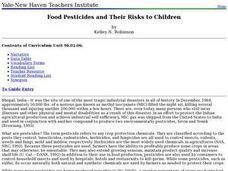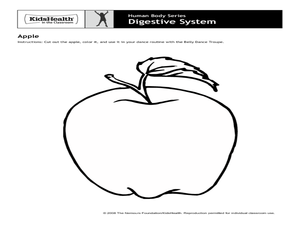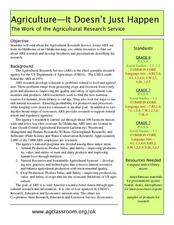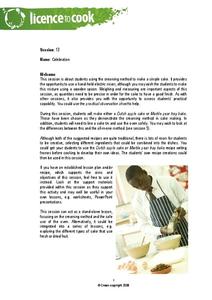Curated OER
Food for Thought: Hunger???Around the Block, Around the World LESSON 2: Local Hunger and Malnutrition
Students examine the difference between hunger and malnutrition. They study the idea of hunger as a theme in literature while discovering how communities can solve hunger problems.
Curated OER
Combining Foods
Students explore addition. For this math lesson, students discover how addition and subtraction are related. Students model related addition and subtraction facts.
Curated OER
Food Pesticides and Their Risks to Children
Students examine an industrial disaster in India which affected the food for generations to come. In groups, they research the history of pesticides and place them into groups based on the type of pests they control. They partcipate in...
True Blue Schools
Now, We’re Cooking!
Practice nutritional cooking with a collection of fun meal preparation lessons. Each lesson includes a focus, objective, collaborative activity, and recipe to culminate what young cooks have learned about healthy eating.
National Institute of Open Schooling
Nomenclature and General Principles
Carbon, the base for all organic compounds, exists in nature in its purest form as graphite or diamonds. The 25th lesson in a series of 36 teaches pupils the nomenclature of organic compounds. Learners read about how to use the IUPAC...
Curated OER
Human Body Series - Digestive System
With articles entitled, "What's Puke?" and "What is a Fart?" this digestive system lesson is sure to be a gas! Elementary anatomists do a belly dance to illustrate how food moves through the digestive system and then design a board game...
CCEA
Home Economics: Teen Building
Learners explore the emotional and nutritional needs of teenagers in a six-lesson unit, which covers such topics as food sources, cooking skills, emotional well-being, and the positive effect of food and family occasions.
Curated OER
Agriculture: It Doesn't Just Happen
After reading an informational text on the Agricultural Research Service, learners research the role of the ARS in Oklahoma. Using reputable online sources, they label a map of the state with relevant areas. Researchers focus on one of...
Curated OER
Restaurants and Institutional Examination 4
Match the vocabulary terms in column A with the definitions in column B. Write the letter of the definition in column B in the space next to the terms in column A.Write short answers or fill in the blank to the following questions and...
Curated OER
From the Farm to Your Table: Where Does Our Food Come From?
Students discover where the food they eat comes from. Using maps, they identify the agricultural areas of the United States and the products that are grown in each area. Using the internet, they research how food gets to America from...
Curated OER
Mexican Food
Young scholars be able to: students identify the foods associated with Mexico and compare and contrast these foods with the foods associated wtih their region of the U.S. They write menus, take quizzes and practice ordering a meal in...
Curated OER
Food Labels in the Classroom
Learners read all information given on packaging; write down complete ingredients and grams of protein, carbohydrates and fat per serving. They compare the information with current health references and write a business letter to a food...
Curated OER
Starvation in the Ghettos
Learners consider the lack of nutrition experienced in Holocaust ghettos. In this Holocaust lesson, students investigate the Nazi policy of starving people out of the ghettos through their food rationing program. Learners compare Nazi...
Curated OER
Math-Addition
Second graders practice adding numbers that add up to less than 100. In this addition activity, 2nd graders use candy to practice adding after participating in a demonstration activity. They complete a worksheet, and an assessment.
Curated OER
Fresh Greens In The Home
Students engage in the study of nutritional food choices that include fresh greens. They investigate the benefits of using simple planting techniques. The lesson also includes recipes for students to try out the habit of eating more food...
Curated OER
WHAT'S ORGANIC?
Middle schoolers explore how certain foods come to be certified "organic." They write the words "organic" and "synthetic" and given the definitions of each. Students are given dictionaries. They are asked: "What is organic food?" Middle...
Curated OER
Web of Predators and Prey
Students investigate the food chain by researching the Internet. In this ecosystem lesson plan, students view the video "Competitor and Predator" and read a book from the series "The Magic School Bus." Students utilize a...
Curated OER
Ocean World
For this components of the ocean worksheet, students answer 20 questions about various species in the ocean such as plankton, different types of whales, sharks, and herring. Students also answer questions about the volume of water in the...
Curated OER
Pizza Muffins & Podcasting
Young scholars investigate life skills by participating in a voice recording activity. In this baking lesson plan, students identify the ingredients needed to create pizza menu items and the steps which should be taken to bake them....
US Citizenship and Immigration Services
Thanksgiving 3—Traditions
Thanksgiving is a treasured national holiday, but it can look different from table to table. Through a reading passage, real-world images, and class discussion, scholars take a look into Thanksgiving's importance to the...
Food a Fact of Life
Pasta Mania
The timing of preparing a roux sauce to accompany either a tuna and broccoli pasta bake or macaroni and cheese is the challenge young cooks face in this foods lesson.
Food a Fact of Life
Celebration
Mastering the creaming method in cake making is featured in a foods activity that asks class members to prepare a Dutch apple cake or a marble pear tray bake. A delicious way to celebrate.
Look! We're Learning!
La Comida!
What would you like to eat? Perhaps una hamburguesa? Teach your class eight Spanish words that relate to food with these cards.
Food a Fact of Life
Soup-er!
Is there anything better than hot soup on a cold day? Kids prepare either vegetable chowder or minestrone soup in an activity that features the use of the stove top.























